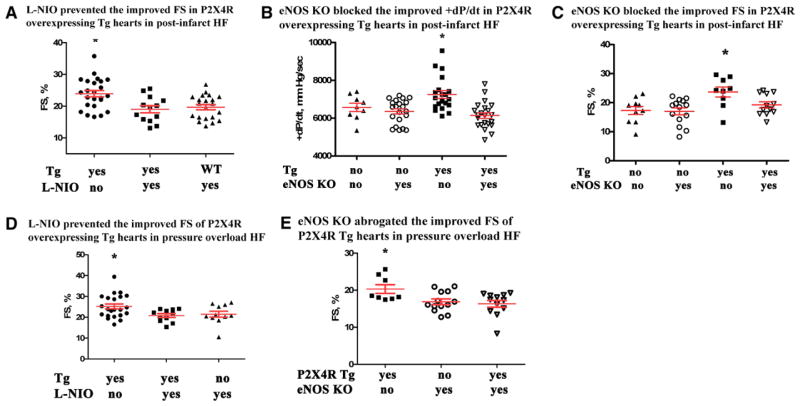Figure 6.
Pharmacological inhibition by L-N5-(1-iminoethyl)ornithine hydrochloride (L-NIO) and genetic knockout (KO) of endothelial NO synthase (eNOS) abrogated the improved cardiac function by P2X4 receptor (P2X4R) overexpression in heart failure. A, Daily injection of L-NIO 3 d before and 7 d after left anterior descending coronary artery (LAD) ligation in P2X4R-overexpressing transgenic (Tg) mice (n=13) resulted in a reduced fractional shortening (FS) compared with Tg mice not receiving drug (ie, receiving vehicle n=24). Tg mice receiving L-NIO had similar FS as WT mice (n=21 WT) receiving the drug. KO of eNOS in P2X4R Tg mice blocked the improved +dP/dt (B) and FS (C) by P2X4R overexpression in postinfarction heart failure. Thirty days after LAD ligation, P2X4R Tg mice (n=20) showed better +dP/dt compared with P2X4R Tg/eNOS KO (n=22), non-Tg WT (n=9), or eNOS KO mice (n=21). Similarly, P2X4R Tg mice (n=9) had greater FS than any other genotype at 30 d after ligation. Non-Tg WT (n=10), eNOS KO (n=14), P2X4R Tg/eNOS KO mice (n=12) did not differ in FS (ANOVA and post-test comparison). D, Using the same drug injection protocol as in A, P2X4R Tg mice treated with vehicle subjected to transverse aorta constriction (TAC; n=22) had higher FS compared with Tg animals that had received L-NIO (n=11); WT animals (n=11) and Tg mice treated with L-NIO had similar FS. E, 21 days after TAC, P2X4R Tg mice (n=8) showed better FS compared with P2X4R Tg/eNOS KO (n=12) or eNOS KO mice (n= 13). *P<0.05 vs any other group. P>0.05 among groups not marked*.

